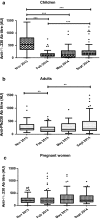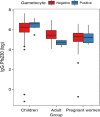The prevalence of submicroscopic Plasmodium falciparum gametocyte carriage and multiplicity of infection in children, pregnant women and adults in a low malaria transmission area in Southern Ghana
- PMID: 30223841
- PMCID: PMC6142636
- DOI: 10.1186/s12936-018-2479-y
The prevalence of submicroscopic Plasmodium falciparum gametocyte carriage and multiplicity of infection in children, pregnant women and adults in a low malaria transmission area in Southern Ghana
Abstract
Background: The gametocyte stage of Plasmodium falciparum is considered an important target for disrupting malaria transmission. Indications are that various demographic groups, such as children and pregnant women may differ in risk of harbouring gametocytes, which may be crucial for targeted control. In this study, the relationship between the prevalence and multiplicity of P. falciparum, asexual parasite infections and gametocytaemia was assessed in three different demographic groups in an area of southern Ghana with low malaria endemicity. Levels of antibody responses to Pfs230 were also assessed as a proxy for the presence of gametocytes.
Methods: The study involved multiple cross-sectional sampling of children (N = 184, aged 2-15 years), male and non-pregnant female adults (N = 154, aged 16-65 years) and pregnant women (N = 125, aged 18-45 years) from Asutsuare in the Shai Osudoku District of Greater Accra Region in Ghana. Asexual parasitaemia was detected by microscopy and PCR, and gametocytaemia was assessed by Pfs25-real time PCR. Multiclonal P. falciparum infections were estimated by msp2 genotyping and an indirect ELISA was used to measure plasma IgG antibodies to Pfs230 antigen.
Results: Overall, children and pregnant women had higher prevalence of submicroscopic gametocytes (39.5% and 29.7%, respectively) compared to adults (17.4%). Multiplicity of infection observed amongst children (3.1) and pregnant women (3.9) were found to be significantly higher (P = 0.006) compared with adults (2.7). Risk of gametocyte carriage was higher in individuals infected with P. falciparum having both Pfmsp2 3D7 and FC27 parasite types (OR = 5.92, 95% CI 1.56-22.54, P = 0.009) compared with those infected with only 3D7 or FC27 parasite types. In agreement with the parasite prevalence data, anti-Pfs230 antibody levels were lower in gametocyte positive adults (β = - 0.57, 95% CI - 0.81, - 0.34, P < 0.001) compared to children.
Conclusions: These findings suggest that children and pregnant women are particularly important as P. falciparum submicroscopic gametocyte reservoirs and represent important focus groups for control interventions. The number of clones increased in individuals carrying gametocytes compared to those who did not carry gametocytes. The higher anti-gametocyte antibody levels in children suggests recent exposure and may be a marker of gametocyte carriage.
Keywords: Gametocyte prevalence; Ghana; Multiplicity of infection; Pfs230; Plasmodium falciparum; Seroprevalence; Submicroscopic infections.
Figures





Similar articles
-
Stage-specific Plasmodium falciparum immune responses in afebrile adults and children living in the Greater Accra Region of Ghana.Malar J. 2020 Feb 10;19(1):64. doi: 10.1186/s12936-020-3146-7. Malar J. 2020. PMID: 32041620 Free PMC article.
-
Immune Responses to Gametocyte Antigens in a Malaria Endemic Population-The African falciparum Context: A Systematic Review and Meta-Analysis.Front Immunol. 2019 Oct 22;10:2480. doi: 10.3389/fimmu.2019.02480. eCollection 2019. Front Immunol. 2019. PMID: 31695697 Free PMC article.
-
Association between alpha-thalassaemia trait, Plasmodium falciparum asexual parasites and gametocyte carriage in a malaria endemic area in Southern Ghana.BMC Res Notes. 2019 Mar 13;12(1):134. doi: 10.1186/s13104-019-4181-8. BMC Res Notes. 2019. PMID: 30867026 Free PMC article.
-
Assessment of submicroscopic infections and gametocyte carriage of Plasmodium falciparum during peak malaria transmission season in a community-based cross-sectional survey in western Kenya, 2012.Malar J. 2016 Aug 19;15(1):421. doi: 10.1186/s12936-016-1482-4. Malar J. 2016. PMID: 27543112 Free PMC article.
-
Molecular approaches to monitor parasite genetic complexity in the transmission of Plasmodium falciparum malaria.Parassitologia. 2005 Jun;47(2):199-203. Parassitologia. 2005. PMID: 16252474 Review.
Cited by
-
Plasmodium falciparum Malaria Parasites in Ghana Show Signatures of Balancing Selection at Artemisinin Resistance Predisposing Background Genes.Evol Bioinform Online. 2021 Mar 3;17:1176934321999640. doi: 10.1177/1176934321999640. eCollection 2021. Evol Bioinform Online. 2021. PMID: 33746510 Free PMC article.
-
Stage-specific Plasmodium falciparum immune responses in afebrile adults and children living in the Greater Accra Region of Ghana.Malar J. 2020 Feb 10;19(1):64. doi: 10.1186/s12936-020-3146-7. Malar J. 2020. PMID: 32041620 Free PMC article.
-
Plasmodium falciparum gametocyte carriage in longitudinally monitored incident infections is associated with duration of infection and human host factors.Sci Rep. 2023 May 1;13(1):7072. doi: 10.1038/s41598-023-33657-3. Sci Rep. 2023. PMID: 37127688 Free PMC article.
-
Immune Responses to Gametocyte Antigens in a Malaria Endemic Population-The African falciparum Context: A Systematic Review and Meta-Analysis.Front Immunol. 2019 Oct 22;10:2480. doi: 10.3389/fimmu.2019.02480. eCollection 2019. Front Immunol. 2019. PMID: 31695697 Free PMC article.
-
Factors associated with sub-microscopic placental malaria and its association with adverse pregnancy outcomes among HIV-negative women in Dar es Salaam, Tanzania: a cohort study.BMC Infect Dis. 2020 Oct 27;20(1):796. doi: 10.1186/s12879-020-05521-6. BMC Infect Dis. 2020. PMID: 33109111 Free PMC article.
References
-
- WHO. World malaria report. Geneva: World Health Organization; 2016. http://www.who.int/malaria/publications/world-malaria-report-2016/report.... Accessed 15 Nov 2017
-
- GHS. Annual Report of the Ghana National Malaria Control Programme, Ministry of Health, Accra, 2014.
MeSH terms
Substances
LinkOut - more resources
Full Text Sources
Other Literature Sources
Medical

